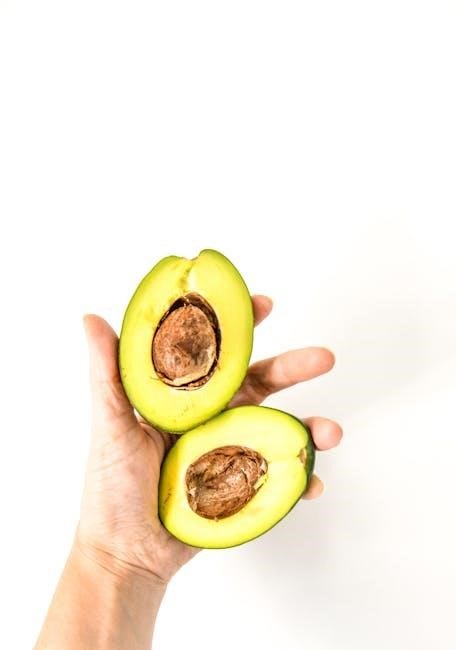A low histamine diet helps reduce histamine intake, alleviating symptoms like digestive issues and skin problems. It’s a structured approach to managing histamine intolerance effectively.
1.1 What is Histamine and Its Role in the Body
Histamine is a naturally occurring compound involved in immune responses, digestion, and nerve function. It plays a key role in allergic reactions, acting as a neurotransmitter and signaling molecule. Histamine helps regulate stomach acid production and is released during immune responses to protect the body. However, excessive histamine levels can cause symptoms like itching, inflammation, and digestive issues. Balancing histamine is crucial for overall health, and dietary adjustments can help manage its effects in sensitive individuals.
1.2 Understanding Histamine Intolerance
Histamine intolerance occurs when the body cannot effectively break down histamine due to low levels of the enzyme diamine oxidase (DAO). This leads to excessive histamine accumulation, causing symptoms such as hives, digestive discomfort, and respiratory issues. Common triggers include consuming aged cheeses, fermented foods, and alcohol. Managing symptoms often involves adopting a low histamine diet to reduce histamine intake and alleviate discomfort. Early identification of triggers is essential for effective management and improving quality of life.
1.3 Benefits of a Low Histamine Diet
A low histamine diet can significantly reduce symptoms of histamine intolerance, such as hives, digestive discomfort, and breathing difficulties. By minimizing histamine intake, it helps stabilize histamine levels, alleviating inflammation and improving overall well-being. This diet also encourages the identification of specific histamine triggers, enabling personalized dietary adjustments. While it is not a cure, it serves as an effective tool for managing symptoms and enhancing quality of life for those with histamine-related sensitivities.

Foods to Avoid on a Low Histamine Diet
Foods high in histamine, histamine-releasing, or DAO-blocking should be avoided to reduce histamine buildup and manage symptoms. This category includes fermented foods, aged cheeses, and processed meats.
2.1 High Histamine Foods
High histamine foods include aged cheeses, fermented meats, fish, and processed items. Examples are aged cheeses like Parmesan and Blue cheese, processed meats such as salami, and fish like mackerel and sardines. Fermented foods, including sauerkraut and kimchi, are also high in histamine. Even fresh fish can accumulate histamine if not stored properly. These foods naturally contain histamine, which can worsen intolerance symptoms. Avoiding them is crucial for managing histamine-related issues effectively.
- Aged cheeses (Parmesan, Blue cheese)
- Fermented meats (salami, prosciutto)
- Canned or fermented fish (mackerel, sardines)
- Fermented vegetables (sauerkraut, kimchi)
- Processed foods with histamine
2.2 Histamine-Releasing Foods
Histamine-releasing foods trigger the body to release stored histamine, exacerbating symptoms. Common culprits include citrus fruits, strawberries, tomatoes, chocolate, and spices like cumin and paprika. Alcohol and certain food additives also fall into this category. These foods don’t necessarily contain high histamine but stimulate its release, making them problematic for those with intolerance. Identifying and avoiding these triggers is essential for managing symptoms effectively.
- Citrus fruits (oranges, lemons)
- Strawberries and tomatoes
- Chocolate
- Spices (cumin, paprika)
- Alcohol and food additives
2.3 DAO-Blocking Foods
DAO-blocking foods inhibit the enzyme diamine oxidase, which breaks down histamine in the gut. When DAO is blocked, histamine accumulates, worsening intolerance symptoms. Common DAO inhibitors include alcohol, tea, coffee, and certain medications. Some foods like processed meats and fish may also interfere with DAO function. Avoiding these is crucial to maintain proper histamine metabolism and reduce symptom severity.
- Alcohol
- Tea and coffee
- Processed meats
- Certain medications

Foods to Include on a Low Histamine Diet
Focus on fresh meats, poultry, fish, and non-fermented vegetables. Include healthy fats like olive oil and coconut oil. Fresh fruits like mangoes and pears are ideal.
- Fresh meats
- Poultry
- Fish
- Non-fermented vegetables
- Healthy fats
- Fresh fruits
3.1 Fresh Meats and Poultry
Fresh meats and poultry are foundational in a low histamine diet. Opt for fresh cuts of beef, chicken, turkey, and pork, ensuring no aging or fermentation. These proteins are naturally low in histamine and provide essential nutrients. Avoid processed or cured varieties, as they tend to be high in histamine. Cooking methods like grilling, baking, or stir-frying are ideal. Always choose fresh over frozen to minimize histamine buildup during storage. Incorporating these meats helps maintain balanced nutrition while adhering to dietary restrictions.
- Fresh beef
- Chicken
- Turkey
- Pork
3.2 Fresh Fish and Seafood
Fresh fish and seafood are excellent choices for a low histamine diet, providing essential omega-3 fatty acids and proteins. Opt for freshly caught or stored options like cod, salmon, and tilapia. Avoid fermented, aged, or canned varieties, as they tend to accumulate histamine. Shrimp, lobster, and crab are also suitable if consumed fresh. However, scombroid fish like tuna and mackerel should be eaten cautiously due to potential histamine buildup. Freshness is key to minimizing histamine content in these foods.
- Cod
- Salmon
- Tilapia
- Shrimp
- Lobster
- Crab
3.3 Low Histamine Vegetables
Low histamine vegetables are a great addition to the diet, offering essential nutrients and fiber. Fresh options like arugula, asparagus, and broccoli are ideal. Avoid fermented or aged vegetables, as they may contain higher histamine levels. Leafy greens like spinach and kale are also suitable if consumed fresh. Cruciferous vegetables like cauliflower and Brussels sprouts are generally well-tolerated. Freshness is key to minimizing histamine content, so opt for fresh, raw, or lightly cooked varieties. Incorporate a variety of colorful vegetables to ensure a balanced intake of vitamins and minerals.
- Arugula
- Asparagus
- Broccoli
- Spinach
- Kale
- Cauliflower
- Brussels Sprouts
3.4 Low Histamine Fruits
Low histamine fruits are a healthy and flavorful addition to the diet. Fresh options like mangoes, kiwis, and pineapples are excellent choices. Avoid overripe or fermented fruits, as they may contain higher histamine levels. Berries, such as strawberries and blueberries, are generally tolerated but should be consumed in moderation. Bananas and apples are also suitable, provided they are fresh. Freshness is crucial to minimizing histamine content, so opt for ripe but not overripe fruits. Incorporate a variety of colorful fruits to ensure a balanced intake of vitamins and antioxidants.
- Mangoes
- Kiwis
- Pineapples
- Strawberries
- Blueberries
- Bananas
- Apples
3.5 Grains and Starches
Certain grains and starches are suitable for a low histamine diet, providing essential nutrients and energy. Rice, quinoa, and oats are excellent choices, as they are naturally low in histamine. Starchy vegetables like sweet potatoes and fresh corn are also safe. These foods help balance meals and provide sustained energy. Always opt for fresh, unprocessed options to avoid histamine buildup. Incorporating these grains and starches ensures a well-rounded diet without adding histamine-related burdens.
- Rice
- Quinoa
- Oats
- Sweet Potatoes
- Fresh Corn
3.6 Healthy Fats and Oils
Healthy fats and oils are essential for a balanced low histamine diet. Opt for fresh, unprocessed options like coconut oil, olive oil, and avocado oil, which are naturally low in histamine. These fats support energy production and overall health. Ensure oils are stored properly to avoid oxidation, as rancidity can increase histamine-like compounds. Avoid processed or fermented oils, as they may trigger histamine release. Incorporating these fats in moderation helps maintain nutritional balance without compromising histamine sensitivity.
- Coconut Oil
- Olive Oil
- Avocado Oil
Sample 3-Day Meal Plan
A 3-day meal plan provides a structured approach to low histamine eating, ensuring fresh, histamine-friendly foods are incorporated into balanced breakfasts, lunches, and dinners.
4.1 Day 1: Breakfast, Lunch, and Dinner Ideas
Start with a fresh mango green smoothie for breakfast, combining spinach, mango, and coconut water. Lunch features grilled chicken salad with mixed greens, cucumber, and olive oil dressing. Dinner includes baked cod with steamed broccoli and quinoa. These meals emphasize fresh, low-histamine ingredients, ensuring a balanced and symptom-friendly diet. Always prioritize fresh preparation to avoid histamine buildup.
4.2 Day 2: Breakfast, Lunch, and Dinner Ideas
Begin Day 2 with scrambled eggs, fresh spinach, and a side of berries. For lunch, enjoy a turkey lettuce wrap with sliced cucumber and fresh herbs. Dinner features grilled shrimp with zucchini noodles and olive oil. These meals focus on fresh, low-histamine ingredients to minimize symptoms and support overall well-being. Always opt for fresh preparation to avoid histamine accumulation.
4.3 Day 3: Breakfast, Lunch, and Dinner Ideas
Start Day 3 with a bowl of oatmeal topped with fresh mango and a drizzle of coconut oil. For lunch, opt for a mixed green salad with sliced chicken breast, cucumber, and a light olive oil dressing. Dinner features pan-seared cod paired with steamed asparagus and a side of cauliflower rice. These meals emphasize fresh, low-histamine ingredients to support your dietary goals and reduce inflammation. Fresh preparation is key to maintaining histamine stability in these dishes;
Guidelines for Implementing the Diet
Focus on fresh foods, avoid additives, and gradually transition to minimize discomfort. Consulting a dietician ensures a personalized and sustainable approach to the low histamine diet plan.
5.1 How to Transition to a Low Histamine Diet
Transitioning to a low histamine diet involves gradual changes to minimize discomfort. Start by identifying and eliminating high histamine foods, then introduce low histamine alternatives. Focus on fresh ingredients, as aged or fermented foods are high in histamine. Keep track of symptoms using a food diary to monitor progress and identify triggers. Consulting a healthcare provider or dietitian can provide personalized guidance, ensuring a smooth and effective transition to the new dietary plan.
5.2 Importance of Food Freshness
Freshness is crucial on a low histamine diet, as histamine levels increase in foods over time. Fresh meats, fish, and produce are optimal, while aged or fermented foods should be avoided. Histamine forms naturally as foods age, especially in proteins like fish and meat. Storing foods properly, such as refrigerating or freezing, can help maintain freshness and reduce histamine accumulation. Prioritizing fresh ingredients ensures a lower histamine intake and minimizes potential symptom triggers.
5.3 Avoiding Food Additives and Preservatives
Certain food additives and preservatives can trigger histamine release or block DAO enzyme function, worsening symptoms. Common culprits include artificial colors, MSG, aspartame, and sodium benzoate. Preservatives like nitrates and sulfites, often found in processed meats and wines, can also elevate histamine levels. Opting for whole, unprocessed foods and reading labels diligently helps minimize exposure. Fresh, organic choices are ideal, as they tend to have fewer additives. Avoiding these chemicals is key to maintaining a low histamine diet and reducing potential triggers.
The Role of a Food Diary
A food diary helps track symptoms, food intake, and potential triggers, aiding in identifying histamine-related reactions and refining dietary choices for better symptom management.
6.1 Tracking Symptoms and Food Intake
Tracking symptoms and food intake in a diary is crucial for identifying patterns and triggers. By documenting meals and reactions, individuals can pinpoint which foods may cause histamine-related issues. This systematic approach helps refine the diet plan, ensuring it effectively reduces symptoms. Over time, the diary becomes a valuable tool for understanding personal tolerance levels and making informed dietary choices. Regular updates and reviews of the diary can lead to better symptom management and a more tailored low histamine diet plan.
6.2 Identifying Personal Histamine Triggers
Identifying personal histamine triggers involves a systematic approach to track and correlate food intake with symptoms. By documenting meals and reactions, individuals can pinpoint specific foods that may cause histamine-related issues. This process often begins with an elimination phase, removing high histamine foods, followed by gradual reintroduction to observe reactions. Over time, patterns emerge, allowing for a more personalized diet plan. This step is essential for long-term success, as triggers vary widely among individuals, and understanding them ensures a tailored approach to managing histamine intolerance effectively.
Importance of Consulting a Healthcare Provider
Consulting a healthcare provider is crucial for personalized guidance, medical testing, and ensuring a safe transition to a low histamine diet tailored to individual needs.
7.1 Working with a Registered Dietitian
A registered dietitian specializes in creating personalized low histamine diet plans, ensuring nutritional needs are met while minimizing symptoms. They can help identify histamine triggers and monitor progress, providing tailored meal ideas and strategies to maintain a balanced diet. Collaborating with a dietitian ensures a structured approach, making the transition to a low histamine lifestyle manageable and sustainable for long-term health benefits.
7.2 Medical Testing for Histamine Intolerance
Medical testing for histamine intolerance involves assessing histamine levels and DAO enzyme activity to confirm diagnosis. Blood tests can measure diamine oxidase (DAO) levels, while histamine levels in blood or urine may indicate intolerance. These tests help identify if histamine buildup is causing symptoms. A healthcare provider can interpret results and recommend tailored dietary adjustments or supplements. Accurate testing ensures personalized treatment plans, addressing the root cause of histamine-related issues effectively.

Common Challenges on a Low Histamine Diet
Managing food cravings, social dining challenges, and ensuring nutrient-rich meals are common hurdles on a low histamine diet. These obstacles require careful planning and dedication.
8.1 Managing Cravings for High Histamine Foods
Cravings for high histamine foods can be challenging due to their flavorful appeal. To manage them, focus on meal planning with fresh, nutrient-dense alternatives. Incorporate healthy fats, fresh meats, and low histamine vegetables to satisfy hunger and reduce cravings. Mindful eating and identifying emotional triggers can also help. Gradually introducing low histamine substitutes for favorite dishes can make the transition smoother and more sustainable in the long term.
8.2 Social and Practical Challenges
Adopting a low histamine diet can present social and practical hurdles. Social gatherings often center around food, making it difficult to avoid high histamine options. Meal preparation requires careful planning to ensure freshness and avoid histamine-releasing additives. Dining out can be challenging due to limited control over ingredients. Additionally, the restrictive nature of the diet may lead to feelings of isolation or frustration. However, with creativity and communication, these challenges can be navigated, ensuring both social engagement and adherence to dietary needs.
8.3 Nutritional Deficiencies to Watch For
A low histamine diet may lead to nutritional deficiencies if not properly balanced. Restricting fermented foods can reduce vitamin B12 intake, while avoiding certain fruits and vegetables may lower vitamin C and fiber consumption. Limiting whole grains can result in fewer B vitamins and minerals like iron and magnesium. It’s crucial to ensure a diverse diet rich in allowable foods to maintain nutrient levels and prevent deficiencies. Consulting a dietitian can help address these concerns and promote long-term health.
Customizing the Diet
The low histamine diet is a tool for identifying tolerance levels. Work with a healthcare provider to craft a personalized plan addressing specific needs and triggers effectively.
9.1 Tailoring the Diet to Individual Needs
Customizing the low histamine diet involves identifying personal triggers and tolerance levels. Start with an elimination phase, removing high histamine foods, and monitor symptoms. Gradually reintroduce foods to pinpoint reactions. Work with a healthcare provider or dietitian to ensure the diet meets nutritional needs while addressing specific intolerances. This tailored approach helps create a sustainable, long-term plan that balances histamine management with dietary variety and enjoyment.
9.2 Reintroducing Foods After the Initial Phase
After the initial phase of a low histamine diet, reintroducing foods should be done systematically. Start with one food at a time, monitoring for symptoms like digestive discomfort or skin issues. Keep a food diary to track reactions and identify triggers. Allow 2-3 days between introductions to assess tolerance accurately. Work with a healthcare provider or dietitian to ensure a balanced diet while minimizing unnecessary restrictions. This step helps create a personalized plan tailored to your histamine tolerance and nutritional needs.

Resources and Tools
Utilize printable low histamine food lists, PDF meal plans, and comprehensive guides to streamline your diet. These resources provide structured approaches and expert recommendations for success.
10.1 Printable Low Histamine Food List
A printable low histamine food list is an essential tool for planning meals. It categorizes foods into high and low histamine options, helping you make informed choices. These lists often include fresh meats, fish, and vegetables while excluding fermented or aged foods. Many online resources offer downloadable PDF versions, making it easy to reference while shopping or cooking. Using a printable list ensures clarity and consistency, helping you avoid histamine triggers and maintain a balanced diet. It’s a practical starting point for anyone new to this dietary approach.
10.2 Low Histamine Diet Plan PDF Downloads
Low histamine diet plan PDF downloads offer structured guidance for managing histamine intolerance. These downloadable resources often include meal plans, recipes, and shopping lists tailored to reduce histamine intake. Many healthcare providers and wellness websites provide these plans, ensuring accessibility for those starting the diet. PDFs typically feature sample menus, histamine-friendly food options, and practical tips for meal preparation. They serve as a convenient reference, helping individuals maintain consistency and ease while following a low histamine lifestyle. Customizable options are also available to suit individual dietary needs and preferences.
10.3 Recommended Books and Websites
For in-depth guidance, several books and websites specialize in low histamine diets. Titles like The Low Histamine Cookbook offer recipes and meal ideas tailored to histamine intolerance. Websites such as Mast Cell 360 provide comprehensive food lists and Histamine Intolerance 101 guides. These resources often include expert advice, ensuring a well-rounded approach to managing histamine levels. They cater to both beginners and those looking to refine their diet, making it easier to adopt and maintain a low histamine lifestyle effectively.
A low histamine diet is a valuable tool for managing symptoms and improving quality of life. It’s essential to customize the diet and address root causes for long-term success.
11.1 Summary of Key Points
A low histamine diet is a temporary solution to manage symptoms by reducing histamine intake. Focus on avoiding high histamine foods, histamine-releasing, and DAO-blocking foods. Customization is crucial, as individual tolerance varies. Work with healthcare providers to address root causes and prevent nutrient deficiencies. Use resources like a low histamine diet plan PDF for guidance. Tracking symptoms in a food diary helps identify triggers. Long-term success requires a balanced approach and understanding of histamine intolerance, ensuring a sustainable and personalized diet plan.
11.2 Encouragement for Long-Term Success
Staying committed to a low histamine diet requires patience and persistence. Celebrate small victories, like symptom relief, to stay motivated. Remember, this diet is a tool to improve well-being, not a restriction. By focusing on fresh, nutrient-rich foods and avoiding triggers, you can achieve long-term success. Tracking progress in a food diary and seeking support from healthcare providers can enhance your journey. Embrace the diet as a lifestyle change, knowing it empowers you to manage histamine intolerance effectively and live a healthier life.



